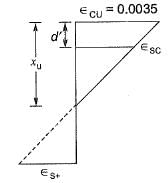Test: Beams & Slabs - 2 - Civil Engineering (CE) MCQ
20 Questions MCQ Test Topicwise Question Bank for Civil Engineering - Test: Beams & Slabs - 2
In a reinforced concrete T-beam (in which the flange is in compression). The position of neutral axis will
The maximum depth of neutral axis for a beam with ‘ d ’ as the effective depth, in limit state method of design for Fe 415 steel is
A reinforced concrete beam is subjected to the following bending moments:
Dead load - 20 kN-m
Live load - 30 kN-m
Seismic load - 10 kN-m
The design bending moment for limit state of collapse is
Dead load - 20 kN-m
Live load - 30 kN-m
Seismic load - 10 kN-m
The design bending moment for limit state of collapse is
In a cantilever beam carrying gravity load, main reinforcement is provided
A doubly reinforced concrete beam has effective cover d' to the centre of compression reinforcement, ‘xu' is the depth of neutral axis, and 'd' is the effective depth to the centre of tension reinforcement. What is the maximum . strain in concrete at the level of compression reinforcement?
Consider the following statements:
In an under-reinforced concrete beam,
1. actual depth of neutral axis is less than the critical depth of neutral axis.
2. concrete reaches ultimate stress prior to steel reaching the ultimate stress.
3. moment of resistance is less than that of balanced sections.
4. lever arm of resisting couple is less than of balanced sections.
Which of these statements is/are correct?
The maximum strain in the tension reinforcement in the section at failure when designed for the limit state of collapse should be
where, fy = Characteristic strength of steel, and Es = Modulus of elasticity of steel
In the case of a continuous RC beam, in order to obtain the maximum positive span moment, where should the live load be placed?
Usually stiffness of a simply supported beam is satisfied if the ratio of its span to depth does not exceed which one of the following?
In a singly reinforced concrete beam section, maximum compressive stress in concrete and tensile stress reach their permissible stresses simultaneously. What is such a section called?
What shall be the maximum area of reinforcement
(i) in compression and
(ii) intension to be provided in an RC beam, respectively, as per IS:456?
In limit state design method, the moment of resistance for a balanced section using M20 grade concrete and HYSD steel of grade Fe 415 is given by Mu.lim = Kbd2, what is the value of K?
How is the deflection in RC beams controlled as per IS:456?
What is the adoptable maximum spacing between vertical stirrups in an RCC beam of rectangular cross-section having an effective depth of 300 mm?
A simply supported RC beam having clear span 5 m and support width 300 mm has the cross- section as shown in figure below.

What is the effective span of the beam as per 1S:456?
What is the modular ratio to be used in the analysis of RC beams using working stress method if the grade of concrete is M20?
In RCC beams, as the percentage area of tensile steel increases
The total compressive force at the time of failure of a concrete beam section of width 'b' without considering the partial safety factor of the material is
Where xu is the depth of neutral axis, fck cube strength of concrete.
A floor slab of thickness t, is cast monolithically transverse to a rectangular continuous beam of span, L and width, B. If the distance between two consecutive points of contraflexure is, Lo, the effective width of compression flange at a continuous support is




















